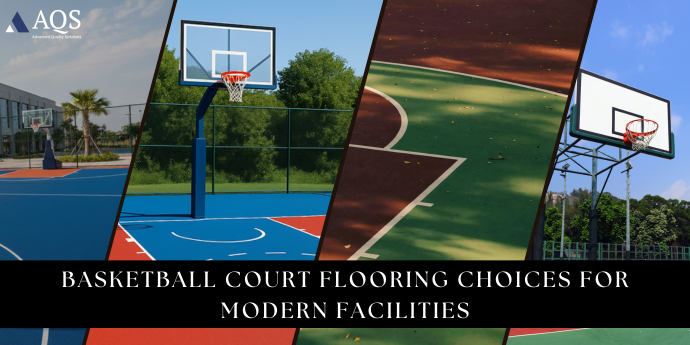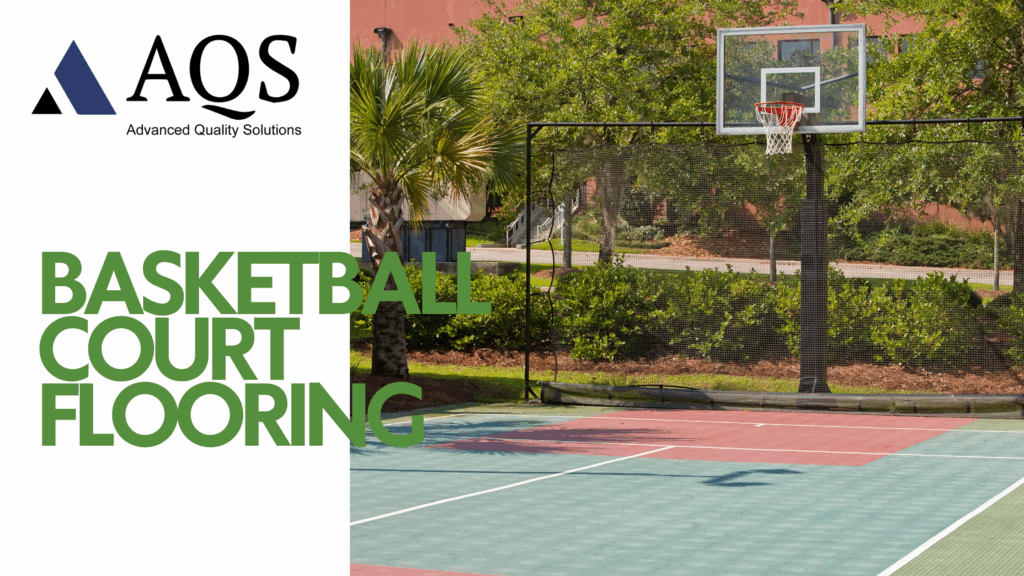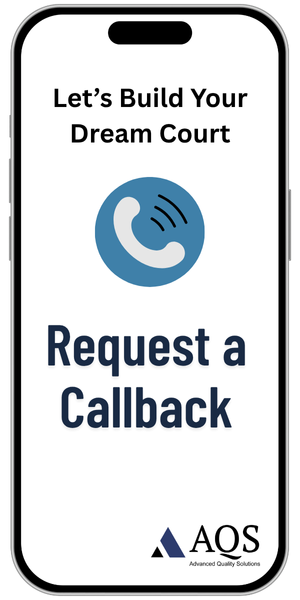Basketball has become one of the fastest growing sports in Indian schools, housing societies and community clubs. With its fast pace, minimal equipment required and universal appeal, the demand for dedicated basketball courts has increased in recent years. However, building a professional court feels like a costly dream. For many decision makers, the challenge lies in balancing performance with affordability finding cheapest outdoor basketball court flooring that doesn’t compromise on safety, durability or playing experience.
In this guide, AQS draws upon years of experience in basketball court construction to show how low cost flooring systems can still achieve professional standards. You will learn about different material options, the real basketball court installation cost, factors that affect project cost and practical maintenance tips to extend surface life. Whether you are a sports facility manager, a school administrator or simply someone planning to install an outdoor basketball court in your community, this blog will help you make informed decisions backed by technical expertise and practical knowledge.
Affordable Basketball Courts: Safe, Consistent and Weather-Resistant
The word cheap in sports infrastructure makes us think of poor finishes, slippery paint, cracks or fading surfaces. But when the basketball court is installed in the right way it makes the basketball court budget friendly. The key is to focus on three things: base preparation, surface system and detailing.
- Right Base:
A well engineered base of asphalt or RCC with proper drainage and slope is the most important factor for durability. Without it, even the best basketball surface material will fail due to waterlogging and cracks. Industry guidelines recommend a slope of 0.83–1.0% to allow rainwater to drain quickly and protect the flooring system. - Right Surface System:
A textured acrylic surface system ensures outdoor durability, UV resistant and consistent traction in all weather conditions. It also provides predictable ball bounce and player safety at low cost. This makes acrylic best for the long term in budget basketball courts. - Right Detailing:
Giving attention to details like proper basketball court dimensions, safe edging, drainage channels and standard line markings makes it professional. These finishing touches not only enhance player experience. But also extends the life of the basketball court by stopping premature damage. A full basketball court is 28 m × 15 m with extra margins for safe play.
Basketball Court Design & Space Planning
Before choosing the right basketball court surface, you need to consider the layout, space and run-offs. Proper planning ensures safe play, smooth installation and long term durability of the basketball flooring.

- Full Court:
A full size basketball court is 28 m × 15 m of active play area. To make sure player safety, venue guidelines extended the envelope about 32 m × 19 m to allow run-offs, clearances and movement space. This is ideal for schools, academies and sports complexes that need professional level dimensions. - Half Court / Backyard:
Half-court or compact layouts are getting popular for backyard basketball courts and community spaces. You need to plan carefully for drainage, lighting and clearance to ensure safety even in smaller areas. This format gives cost savings and fits perfectly for residential, housing society or training practice use. - Multi-Sport Courts:
One slab can be designed with markings for basketball, futsal, volleyball or badminton. With an acrylic specification offering multi-sport traction and controlled texture, these setups give maximum usage of space. They are most cost effective for institutions, schools and local clubs that want to support multiple sports in one facility.
Why Acrylic Basketball Courts for Outdoor Budgets?
When it comes to cheap outdoor basketball court flooring, textured, water-based acrylic surfacing over a sound base gives you the best of both worlds upfront cost, performance and long term maintenance. Here’s why:
UV & Weather Resistance:
Acrylic is designed to withstand India’s harsh outdoor conditions, heating sun to heavy monsoon rains. The coatings remain color stable and crack resistant so the surface doesn’t fade or worsen quickly. This is ideal for open air courts where climate flexibility is key.
Traction & Consistent Bounce:
The micro textured finish and silica aggregates provide excellent grip without being too rough. Players get a reliable ball response with consistent bounce across the basketball court for training and competitive play. This balance of safety and performance is the overall playing experience.
Low Maintenance & Easy Resurfacing:
Unlike other materials that need costly overhauls, acrylic basketball courts can be maintained with simple cleaning routines and monthly inspections. Every 3-5 years a fresh topcoat can be applied to restore texture, grip and appearance at a fraction of the initial cost. This means longevity and resurfacing is budget friendly.
Versatile Looks:
Acrylic flooring has a wide range of colors, line markings and finishes. So schools, clubs and homeowners can customize their basketball courts. It also supports multi sport overlays and the same surface can be used for basketball, volleyball or tennis. This is value for money and installation is affordable.
Basketball Flooring Materials Comparison
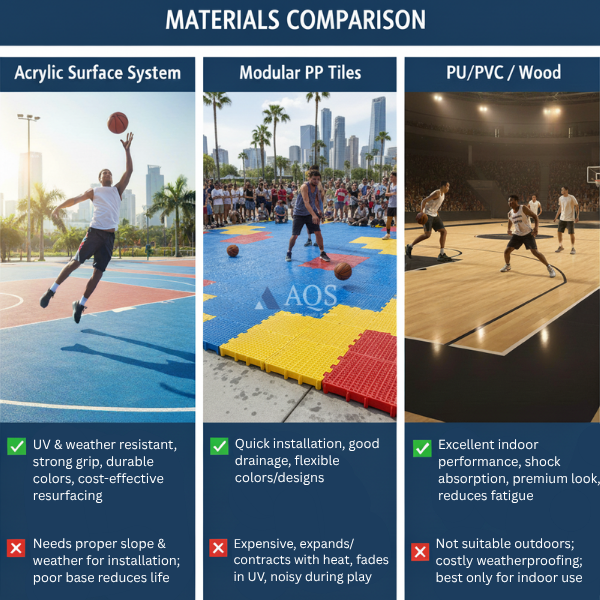
Acrylic Surface System
Pros: Acrylic flooring is weather and UV resistant, perfect for outdoor basketball court flooring in Indian climate. The textured surface provides excellent grip with consistent ball bounce and maintains colors for years. Scales well from small backyard courts to large institutional projects and basketball court resurfacing is cost effective.
Cons: To achieve durability, the base must be engineered with the correct slope to ensure proper drainage. Installation of the basketball court requires favorable weather conditions to avoid rain and extreme heat for better adhesion. Neglecting slope and curing conditions can reduce the flooring’s life and performance.
Modular PP Tiles
Pros: Interlocking tiles are used for quick and clean installation, popular for temporary or portable setups. Under-tile drainage channels stop water seepage, making the surface usable even after rain. Flexibility in design and color options to enhance the basketball court’s look.
Cons: Though convenient, PP tiles are more expensive than acrylic systems. Prone to thermal expansion and contraction which can affect consistency and create visible gaps. Fades in high UV environments and produces noise or vibration during play.
PU/PVC / Wood
Pros: These materials deliver excellent indoor performance with shock absorption to protect players’ joints during intense play. Premium look and feel, often preferred in gymnasiums, arenas or indoor academies. Smooth finish and elasticity reduces fatigue during long practice sessions.
Cons: Not ideal for outdoor use as high UV exposure, rainfall and humidity severely impacts their durability. Weatherproofing them for external courts increases the overall basketball court flooring cost. Hence recommended mainly for controlled indoor environments and not for outdoor installations.
Layer-by-Layer Acrylic Basketball Court Flooring?
- Base with drainage and verified slope
The base is the foundation of the court. A compacted RCC or asphalt base with a 1:100 slope allows water to run off, prevents surface cracks and provides structural stability for years of play. - Primer with the base
A special acrylic primer is applied to seal the surface and bond the base and following layers together. This stops peeling and makes sure the acrylic coating is fixed for long term durability. - Resurfacer
These coats fill tiny pores, hairline cracks and uneven textures in the base. They create a smooth surface that enhances grip, bounce consistency and overall playability of the basketball court. - Cushion Coats
When added, cushion layers introduce elasticity to reduce joint stress and provide shock absorption. Ideal for professional and school courts where players play frequently and need extra comfort. - Color Coats with silica for controlled texture
Acrylic color coats not only look great but also provide UV stability and slip resistance. Silica is blended into the coating to create a textured finish that provides safe traction even in wet conditions.
What Affects Basketball Court Construction Cost?
Whether it’s a school, society, club or backyard basketball court, total cost depends on several key factors:
- Scope (Full vs Half Court):
A full court requires approximately 420 m² of playing surface plus extra margins for safety which increases material and labor cost. A half court or compact training setup can reduce basketball court construction cost significantly while still meeting recreational needs. Project planners should decide scope based on space availability, usage frequency and community requirements. - Base Type & Condition:
Building a new RCC or asphalt base is usually the most expensive part of the project but it ensures strength, drainage and durability. If a solid slab already exists, resurfacing it with acrylic systems can save a big portion of cost. But a poor quality base often needs repairs which can add to the cost before flooring installation begins. - Layer Count:
Basic 5 layer acrylic systems are cost effective for casual play and light usage. For advanced performance, cushioned 7-8 layer systems offer better comfort, impact absorption and professional grade playability but at a higher cost. Choosing the right layer count balances budget constraints with long term performance expectations. - Site Logistics:
Basketball Project cost is also affected by how easily materials, equipment and labor can access the site. Remote areas or difficult entry points may require additional transport or handling charges. Seasonal weather like monsoon rains can delay work and increase cost due to protective measures or rescheduling. - Add-Ons:
Additional features like fencing, LED lighting, seating, branded logos, drainage improvements and professional goal systems can turn a basic basketball court into a high end facility. While these add-ons increase the initial cost, they improve player safety, extend usability and increase the value of the court. Prioritize essential add-ons first to manage budget smartly.
How to Keep Basketball Court Costs Low Without Cutting Corners?
AQS field experience highlights ten practical levers for cheap outdoor basketball court flooring that lasts:
- Get the Base Right Once: Proper subgrade compaction, correct slope and well planned joints prevent cracks and waterlogging that can shorten a court’s life. Investing in a solid base saves you a lot of money in future repairs. A well built base ensures surface adhesion and performance.
- Choose Acrylic Wisely: Always choose the acrylic system based on the level of play expected. A 5 layer system is good for moderate use, a 7-8 layer system is better for high traffic courts. Matching layer count to usage avoids overspending without compromising on durability.
- Plan Weather Resistant: Acrylic systems need dry and moderate weather for curing. Installing during heavy rain or extreme temperatures risks adhesion failure. Plan carefully to ensure the flooring bonds properly, minimizes waste and rework costs.
- Standardize Colors & Lines: While multi color patterns and logos look great, they also add labor and material costs. Choose simple and standardized color schemes first to keep costs low.
- Phase Non-Critical Add-Ons: Features like fencing, seating and landscaping are nice to have but not essential for play. By phasing these, after the court is functional, you can spread out the costs while ensuring timely project delivery.
- Specify Drainage Early: Drainage solutions like gutters, swales and edge detailing are cheaper to integrate during the base construction phase. Plan early to avoid costly retrofits and protect the surface from water damage.
- Protect Edges: Transitioning edges into pavers, turf or soil with durable treatments prevents erosion and undermining. Strong edge protection reduces cracking and surface failure, extending the life of the court.
- Document QA: On-site quality assurance checking thickness, monitoring curing and logging material mixes ensures the flooring meets specs. Documented QA strengthens warranties and avoids costly disputes later.
Basketball Court Design & Standards That Build Trust
Standards-based detailing is what makes a basketball court reliable and safe for years. When basketball court dimensions, equipment and lighting follow global standards, both players and facility managers feel confident in the surface quality. This also reassures insurers and coaches that the court is safe for regulated play.
- Dimensions & Lines: Courts designed to FIBA geometry play the same worldwide. Adequate run-offs and safety margins stop collisions with surrounding structures, so training and competition meet professional standards. Correct markings help player development and referee accuracy.
- Padding & Equipment: Padding around posts, boards and walls minimizes injury risk during high impact play. Using up to date, certified equipment makes sure compliance with safety regulations and durability against heavy outdoor use. This builds trust with athletes, schools and institutions investing in the facility.
- Lighting & Backgrounds: Even outdoor courts have uniform lighting that reduces shadows and glare that affect player vision. Non-reflective, neutral backgrounds makes the ball more visible, reduces eye strain and increases safety. Proper lighting design also extends play hours, so courts can be used in the evening.
Step-By-Step: Outdoor Basketball Court Construction
Site Survey & Soil Review
A site survey helps determine if the ground needs to be cut or filled before construction. Drainage routes are mapped to prevent waterlogging that can damage the flooring system. Access for material delivery and machinery is planned during this stage to ensure smooth execution.
Base Engineering & Construction
A strong RCC or asphalt base is laid with proper compaction for long term stability. Joints are designed to allow for expansion and stop cracks. A slope is maintained so water flows naturally towards drains or edges.
Moisture & Curing Control
Concrete bases need curing time, usually 28 days, to achieve structural strength. Without curing the surface will crack and the flooring layers will not adhere. In sensitive builds vapor barriers are introduced to block moisture rising from below.
Surface Preparation
Before flooring application the base is mechanically cleaned to remove dust, oil or laitance. Any visible cracks are filled with approved fillers to create a smooth finish. Surface profiling makes sure the primer and acrylic layers adhere properly without peeling.
Acrylic System Application
The system starts with primer for bonding, then resurfacer or filler coats to smooth out imperfections. Cushion layers may be added for high play areas. Finally textured color coats and line markings as per FIBA standards complete the court.
Commissioning & Handover
Once completed a final inspection or punch list is done. Thickness and texture checks to ensure the system meets the specifications. The client receives a maintenance guide, warranty documents and resurfacing cycles.
Low Maintenance for Long Life, Low Cost
A simple, low cost care plan keeps outdoor basketball court flooring at its best. Regular maintenance stops major repairs and gives players safe traction and consistent bounce. Quick checks at set intervals extends surface life and reduces overall basketball court cost.
- Weekly: Blow or wash the basketball court surface to remove dust, leaves and grit. These may seem harmless but can trap moisture and cause surface stain or slippery patches. A weekly clean keeps the flooring safe and looking good.
- Monthly: Check the perimeter and surface for blockages at edges, drains and low spots. Waterlogged areas or clogged drainage lines can increase wear and cause cracks or moss to form. Regular checks help identify and fix small issues before they become big.
- Annually: Look for hairline cracks, seal failures or surface peeling twice a year. Fix these early and stop moisture from getting into the base which can compromise fixing and lead to expensive resurfacing. Minor patchwork done quickly saves money and downtime.
- Every 3-5 Years: Resurface to reapply acrylic color and texture layers depending on usage and climate. This refreshes grip, restores color and keeps the basketball court material up to safety and playability standards. Much cheaper than full rebuild and keeps the flooring competitive with new builds.
How AQS Aligns the Basketball Project From Design to Delivery?
AQS focuses on specification integrity and lifecycle value, so every court delivers long term performance not just low upfront cost. Each stage of design, construction and installation is guided by technical precision and international standards.
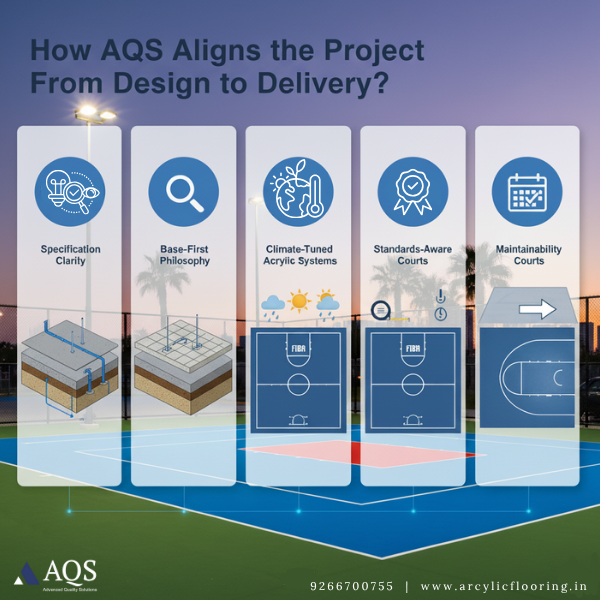
Specification Clarity
Every project starts with documented layer counts, mix ratios and surface texture targets. This clarity eliminates ambiguity during installation and ensures the finished basketball court flooring meets performance expectations. Clients get transparency and consistency.
Base-First Philosophy
Strong surfaces start with strong foundations, that’s why AQS emphasizes civil tolerances, expansion joints and proper slope design. Drainage planning and moisture control measures are integrated from the start to protect the surface from early cracks and water damage.
Climate-Tuned Acrylic Systems
AQS uses UV-stable, weather-resistant acrylic flooring chemistry designed for India’s diverse climate. Whether under intense heat, monsoon rains or humidity, these systems maintain consistent bounce, grip and surface adhesion for years.
Standards-Aware Courts
Courts are designed with FIBA aligned dimensions and safe run-off areas to meet international standards. This ensures training and matches replicate professional conditions, so players feel safe and confident on every bounce.
Maintainability
From day one AQS plans recoat and refresh cycles so ownership costs are predictable. This proactive approach means resurfacing is scheduled before performance declines, extending the life of the flooring and maximizing long term value.
Conclusion
From the base and slope to the number of surface layers, every decision affects basketball court construction cost and long term usability of the facility. By getting installation right, resurfacing on time and maintaining discipline, you can protect your investment and get consistent performance year after year.
AQS is committed to providing tested, standards driven solutions for communities, schools, clubs and homeowners. By combining affordability with engineering precision, we ensure every client gets a basketball flooring system that lasts even in India’s harsh climate. If you want to build an outdoor basketball court that is budget friendly yet professional in quality, talk to AQS first.
Frequently Asked Questions
RCC/asphalt base is the best balance of low cost, good traction and long life.
Acrylic designed for UV, temperature and moisture works outdoors.
They optimize the base and drainage, use right acrylic layer count and stage non-critical add-ons.
Court size (full vs half), base condition, layer count, logistics and add-ons like fencing and lighting.
Every 3-5 years depending on usage, climate and maintenance discipline.
Yes, half-court with value acrylic on a correct base is budget friendly and durable.
Textured acrylic gives controlled traction and sheds water well if slope and drainage is correct.
Full compliance is not required for casual play but FIBA geometry makes sure familiar spacing and training value.

